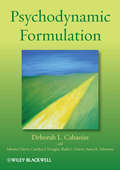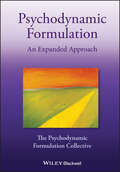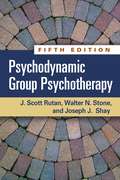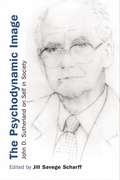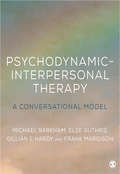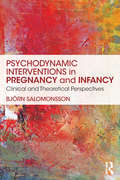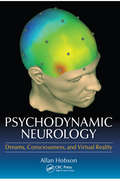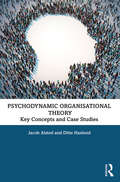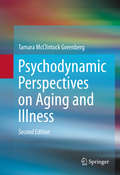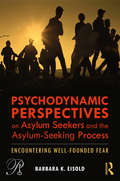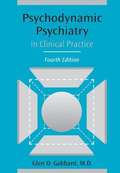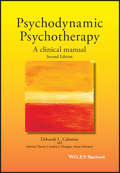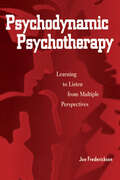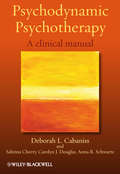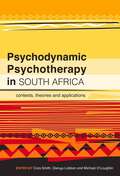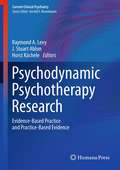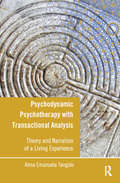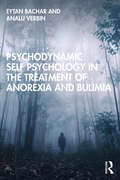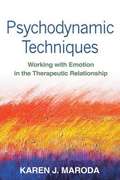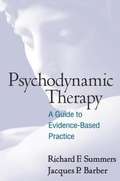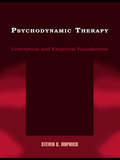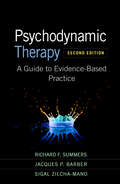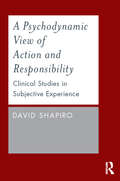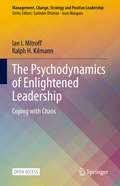- Table View
- List View
Psychodynamic Formulation
by Ruth Graver Anna R. Schwartz Sabrina Cherry Deborah L. Cabaniss Carolyn J. DouglasHow do our patients come to be the way they are? What forces shape their conscious and unconscious thoughts and feelings? How can we use this information to best help them? Constructing psychodynamic formulations is one of the best ways for mental health professionals to answer questions like these. It can help clinicians in all mental health setting understand their patients, set treatment goals, choose therapeutic strategies, construct meaningful interventions and conduct treatment.Despite the centrality of psychodynamic formulation to our work with patients, few students are taught how to construct them in a clear systematic way. This book offers students and practitioners from all fields of mental health a clear, practical, operationalized method for constructing psychodynamic formulations, with an emphasis on the following steps: DESCRIBING problems and patternsREVIEWING the developmental historyLINKING problems and patterns to history using organizing ideas about development.The unique, up-to-date perspective of this book integrates psychodynamic theories with ideas about the role of genetics, trauma, and early cognitive and emotional difficulties on development to help clinicians develop effective formulations.Psychodynamic Formulation is written in the same clear, concise style of Psychodynamic Psychotherapy: A Clinical Manual (Wiley 2011). It is reader friendly, full of useful examples, eminently practical, suitable for either classroom or individual use, and applicable for all mental health professionals. It can stand alone or be used as a companion volume to the Clinical Manual.
Psychodynamic Formulation: An Expanded Approach
by The Psychodynamic Formulation CollectivePsychodynamic Formulation A leading text for psychodynamic clinicians and practitioners Psychodynamic Formulation: An Expanded Approach delivers an exceptional exploration of psychodynamic explanations and hypotheses that seek to explain how a person’s conscious and unconscious thoughts and feelings may have developed and may be causing or contributing to the challenges they face. This latest edition of the leading reference includes a refreshed and reinvigorated emphasis on the impacts of culture and society, as well as the importance of diversity and inclusion, on psychodynamic formulation. It puts new focus on lived experience, including trauma, and on how clinical bias can contribute to the perpetuation of trauma. In addition to newly included activities and exercises, readers will find: A practical, step-by-step guide to collaboratively creating psychodynamic formulations Comprehensive discussions about how what we’re born with and environmental influences contribute to development Suggestions for using psychodynamic formulations in many clinical settings, including acute care and psychopharmacologic treatment An educator’s guide to teaching psychodynamic formulation Perfect for mental health practitioners with a professional or personal interest in psychodynamics/psychoanalysis, Psychodynamic Formulation: An Expanded Approach will earn a place in the libraries of trainees in all mental health fields.
Psychodynamic Group Psychotherapy, Fifth Edition
by Walter N. Stone Joseph J. Shay J. Scott RutanRegarded as the definitive practitioner reference and text, this accessible work addresses all aspects of setting up therapy groups and making them work. A wealth of clinical material illustrates the components of effective group therapy and the mechanisms and processes of change. Practical topics discussed include patient selection and preparation, leadership issues, communication of affect in groups, dealing with "difficult" patients, time-limited groups, and facilitating successful terminations. A chapter-length case example with commentary from each author brings an entire group session to life and explores ways to handle common dilemmas. New to This Edition *Incorporates current theory (psychodynamic and interpersonal), which is grounded in clinical and neurobiological research. *Every chapter revised and updated. *Chapter-length case example is entirely new. *Chapter on Frequently Asked Questions includes many new issues.
The Psychodynamic Image: John D. Sutherland on Self in Society
by Jill Savege ScharffThe Psychodynamic Image is the first selection of John D. Sutherland’s major papers. It provides an overview of the development of his thought on self and society and reveals the extent of his contribution to the field of mental health. Jill Savege Scharff introduces Sutherland’s most important and influential essays. These reflect his range as a theoretician, moving easily from the intrapsychic to the interpersonal level, building bridges between points of view and integrating psychoanalytic and social theories. Sutherland’s work calls for changes at the individual level through understanding conflicts and unconscious processes as aspects of parts of the self in interaction. He inspires respect and understanding of the self and its drive toward autonomy. These papers push the boundaries of psychoanalytic thinking and succeed in demonstrating the relevance of psychoanalysis to the wider society. They will be of great interest to psychoanalysts, psychotherapists, counsellors and social workers.
Psychodynamic-Interpersonal Therapy: A Conversational Model
by Michael Barkham Else Guthrie Professor Gillian E. Hardy Frank MargisonThis book presents for the first time, a practical manual for psychodynamic-interpersonal therapy. Drawing on forty years of research, teaching and practice, its expert authors guide you through the conversational model’s theory, skills and implications for practice. Part I sets out the model’s underlying theory and outlines the evidence for its efficacy with client groups. Part II guides you through clinical skills of the model, from foundational to advanced. Part III offers practical guidance on implementing the approach within a range of settings, and for developing effective practice through reflection and supervision.
Psychodynamic-Interpersonal Therapy: A Conversational Model
by Else Guthrie Frank Margison Professor Gillian E. Hardy Professor Michael BarkhamThis book presents for the first time, a practical manual for psychodynamic-interpersonal therapy. Drawing on forty years of research, teaching and practice, its expert authors guide you through the conversational model's theory, skills and implications for practice. Part I sets out the model's underlying theory and outlines the evidence for its efficacy with client groups. Part II guides you through clinical skills of the model, from foundational to advanced. Part III offers practical guidance on implementing the approach within a range of settings, and for developing effective practice through reflection and supervision.
Psychodynamic Interventions in Pregnancy and Infancy: Clinical and Theoretical Perspectives
by Björn SalomonssonPsychodynamic Interventions in Pregnancy and Infancy builds on Björn Salomonsson’s experiences as a psychoanalytic consultant working with parents and their babies. Emotional problems during the perinatal stages can arise and be observed and addressed by a skilled midwife, nurse or health visitor. Salomonsson has developed a method combining nurse supervision and therapeutic consultations which has lowered the thresholds for parents to come and talk with him. The brief consultations concern pregnant women, mother and baby, husband and wife, toddler and parent. The theoretical framework is psychoanalytic, but the mode of work is eclectic and adapted to the family’s situation and its members’ motivation. This book details such work, which can be applied globally; perinatal psychotherapy integrated with ordinary medical health care. It also explains how psychotherapy can be made more accessible to a larger population. Via detailed case presentations, the author takes the reader through pregnancy, childbirth and the first few years of life. He also brings in research studies emphasizing the importance of early interventions, with the aim of providing therapists with arguments for such work in everyday family health care. To further substantiate such arguments, the book ends with theoretical chapters and, finally, the author’s vision of the future of a perinatal health care that integrates medical and psychological perspectives. Psychodynamic Interventions in Pregnancy and Infancy will appeal to all psychoanalysts and psychoanalytic psychotherapists working in this area, as well as clinical psychologists, clinical social workers and medical personnel working with parents and infants.
Psychodynamic Neurology: Dreams, Consciousness, and Virtual Reality
by Allan HobsonPsychodynamic Neurology: Dreams, Consciousness, and Virtual Realty presents a novel way of thinking about the value of dreaming, based in solid comprehension of scientific research on sleep and dreams, but with deep understanding of psychoanalytic and other interpretations of dreams. <P><P>This book: <li>Surveys the remarkable history of sleep research over the past few decades <li>Examines the neurobiology of sleep and its implications for consciousness and well-being <li>Addresses the nature of waking and dreaming consciousness and how they are deeply related <li>Presents the neurogenesis, function, and clinical importance of a brain-based dream theory <P><P>Our dreams are a mixture of anticipated virtual as well as remembered real experience. This book tells the story of how neuroscience has helped us reach this startling and exciting conclusion and how the new scientific model builds upon and departs from the dream theories of the past.
Psychodynamic Organisational Theory: Key Concepts and Case Studies
by Jacob Alsted Ditte HaslundOn the surface, people go to work and come home again. They sometimes manage people while most are managed themselves. But beneath the function and structures of the work itself, a whole range of emotions affects the success of the relationship between employee and manager and ultimately the organisation they both belong to. Psychodynamic Organisational Theory: Key Concepts and Cases provides a comprehensive but accessible introduction to this fascinating field of study. Featuring case vignettes which bring the various concepts to life, the book is divided into four parts. Part I looks at how the individual relates to the organisation and the unconscious energies they bring, while Part II examines group dynamics and how they affect productivity, including a chapter on meetings. Part III explores the realm of leadership and what roles a manager can play in managing their staff, while Part IV introduces the idea of personality and describes how the manager’s personality influences management dynamics as well as the wider organisational culture. Central to the book, as well as the idea that organisational phenomena are often unconscious, is the understanding that relationships are always reciprocal. Through complex psychological dynamics manager and employee influence and change each other during the process of managing and being managed. This text will be essential reading for students and scholars of leadership, HRM, and organizational psychology, as well as consultants and managers looking for practical insights into how human relationships affect the success of every organisation.
Psychodynamic Perspectives on Aging and Illness
by Tamara Mcclintock GreenbergMore than ever, the aging process is recognized as carrying a special set of emotional challenges-especially when acute or chronic medical conditions are involved. In this light, Psychodynamic Perspectives on Aging and Illness presents a fresh, contemporary application of psychodynamic theory, addressing the complex issues surrounding declining health. Informed by the spectrum of psychodynamic thought from self, relational, and classical theories, this forward looking volume offers more modern interpretations of theory, and techniques for working with a growing, complicated, but surprisingly resilient population. It illuminates how to enhance the therapeutic relationship in key areas such as addressing body- and self-image issues, approach sensitive topics, and understand the disconnect that can occur between medical patients and the often impersonal, technology-driven health care system. At the same time, the author cogently argues for pluralism in a therapeutic approach that is frequently threatened by forces both within and outside the field. Among the topics covered: Medical illness as trauma. Idealization and the culture of medicine. Normative and pathological narcissism in the ill and/or aging patient. Noncompliant and self-destructive behaviors. Transference and countertransference issues. Psychotherapy with cognitively impaired adults. Grief, loss, and hope. Expanding on what we know and candid about what we don't, Psychodynamic Perspectives on Aging and Illness offers mental health researchers and practitioners an insightful framework for improving the lives of older patients.
Psychodynamic Perspectives on Asylum Seekers and the Asylum-Seeking Process: Encountering Well-Founded Fear (Psychoanalysis in a New Key Book Series)
by Barbara K. EisoldPsychodynamic Perspectives on Asylum Seekers and the Asylum-Seeking Process looks at the psychosocial assessment of asylum seekers from three perspectives: forensic, psychodynamic, and political and then attempts to better understand, from a psychodynamic perspective, differences in the historical/motivational routes of asylum seekers themselves. Barbara Eisold begins in Chapter One by exploring the unique evaluation relationship of psychosocial assessment and the striking will to survive of the asylum seekers that it puts into focus, using a psychodynamic lens. The forensic value of psychosocial assessment and its potential as both a political and a therapeutic tool are then described. Chapter Two describes individuals, who, by background and personal characteristics, shared a profound desire to protest, gravely compromising their survival at home and forcing them to seek asylum elsewhere. Chapter Three discusses women who have suffered female genital mutilation and includes a discussion of the development of strong personal agency in one case. Chapter Four describes abused women from Central America forced to flee from femicide. The evolution of femicide is explored, including the development of honor-bound machismo and the wide-spread disregard of law. The hold men have on women is then examined from a psychodynamic perspective. Psychodynamic Perspectives on Asylum Seekers and the Asylum-Seeking Process will be of great interest to psychoanalysts, psychoanalytic psychotherapists, and all mental health professionals working with asylum seekers.
Psychodynamic Psychiatry in Clinical Practice (4th edition)
by Glen O. GabbardThe book introduces the basic principles of psychodynamic psychiatry and the four fundamental theoretical frameworks derived from psychoanalytic theory: ego psychology, object relations theory, self psychology, and attachment theory.
Psychodynamic Psychotherapy: A Clinical Manual
by Carolyn J. Douglas Deborah L. Cabaniss Anna R. Schwartz Sabrina CherryAn updated and expanded new edition of a widely-used guide to the theory and practice of psychodynamic psychotherapy, providing material for readers to apply immediately in their treatment of patients. Built around a unique and proven approach that clearly teaches psychodynamic psychotherapy using three key steps - listening, reflecting, and intervening Features new and expanded workbook-style exercises across all chapters, helping readers to translate what they are learning into real-world practice with patients Offers a comprehensive learning guide for psychodynamic therapy based on a proven syllabus for trainees in psychiatry, psychology, social work, medicine, nursing, and psychoanalysis A clear and comprehensive teaching text, now supported by a brand new educators' guide to assist teachers and program directors in making best use of the material in training programs
Psychodynamic Psychotherapy: Learning to Listen from Multiple Perspectives
by Jon FredericksonFirst published in 1999. Routledge is an imprint of Taylor & Francis, an informa company.
Psychodynamic Psychotherapy
by Anna R. Schwartz Sabrina Cherry Deborah L. Cabaniss Carolyn J. DouglasPsychodynamic psychotherapy offers people a chance to create new ways of thinking and behaving in order to improve the quality of their lives.This book offers a practical, step-by-step guide to the technique of psychodynamic psychotherapy, with instruction on listening, reflecting, and intervening. It will systematically take the reader from evaluation to termination using straightforward language and carefully annotated examples. Written by experienced educators and based on a tried and tested syllabus, this book provides clinically relevant and accessible aspects of theories of treatment processes. The workbook style exercises in this book allow readers to practice what they learn in each section and more "actively" learn as they read the book.This book will teach you:About psychodynamic psychotherapy and some of the ways it is hypothesized to workHow to evaluate patients for psychodynamic psychotherapy, including assessment of ego function and defensesThe essentials for beginning the treatment, including fostering the therapeutic alliance, setting the frame, and setting goalsA systematic way for listening to patients, reflecting on what you've heard, and making choices about how and what to sayHow to apply the Listen/Reflect/Intervene method to the essential elements of psychodynamic techniqueHow these techniques are used to address problems with self esteem, relationships with others, characteristic ways of adapting, and other ego functionsWays in which technique shifts over timeThis book presents complex concepts in a clear way that will be approachable for all readers. It is an invaluable guide for psychiatry residents, psychology students, and social work students, but also offers practicing clinicians in these areas a new way to think about psychodynamic psychotherapy. The practical approach and guided exercises make this an exceptional tool for psychotherapy educators teaching all levels of learners.This book includes a companion website: www.wiley.com/go/cabaniss/psychotherapywith the "Listening Exercise" for Chapter 16 (Learning to Listen). This is a short recording that will help the reader to learn about different ways we listen.Praise for Psychodynamic Psychotherapy: A Clinical Manual"This book has a more practical, hands-on, active learning approach than existing books on psychodynamic therapy."Bob Bornstein, co-editor of Principles of Psychotherapy; Adelphi University, NY"Well-written, concise and crystal clear for any clinician who wishes to understand and practice psychodynamic psychotherapy. Full of real-world clinical vignettes, jargon-free and useful in understanding how to assess, introduce and begin psychotherapy with a patient. Extraordinarily practical with numerous examples of how to listen to and talk with patients while retaining a sophistication about the complexity of the therapeutic interaction. My trainees have said that this book finally allowed them to understand what psychodynamic psychotherapy is all about!"--Debra Katz, Vice Chair for Education at the University of Kentucky and Director of Psychiatry Residency Training"This volume offers a comprehensive learning guide for psychodynamic psychotherapy training."--Robert Glick, Professor, Columbia University(Cover painting by Nicki Averill)
Psychodynamic Psychotherapy in South Africa: Contexts, theories and applications
by Giada Del Fabbro Glenys Lobban Michael O’Loughlin Gillian EaglePsychoanalysis as a long term modality is inaccessible to the average South African. In this book the authors describe how psychoanalytically orientated or psychodynamic psychotherapy can be practiced as a short-term endeavour and applied to contemporary issues facing the country. Psychodynamic work is currently undertaken by clinical psychologists, therapists, clinicians, trainers, teachers, clinical supervisors, consultants and researchers working in university settings, state hospitals, community projects, private practice and research. The debates, clinical issues, therapeutic practice and nature of research covered in the book are widely representative of the work being done in the country. The need for shorter term therapy models and evidence-based interventions is as acute in global practice as it is locally. The lessons learned in South Africa have broader implications for international practitioners, and the authors stress the potential inherent in psychoanalytic theory and technique to tackle the complex problems faced in all places and settings characterised by increasing globalisation and dislocation. The book is structured in three main sections. Psychodynamic Psychotherapy in South Africa is aimed at local and international practitioners and students, while non-specialist readers will find the text informative and accessible.
Psychodynamic Psychotherapy Research
by J. Stuart Ablon Raymond A. Levy Horst KächelePsychodynamic Psychotherapy Research: Evidence-Based Practice and Practice-Based Evidence continues the important work of the first book published in 2009 by Humana Press (Handbook of Evidence-Based Psychodynamic Psychotherapy: Bridging the Gap Between Science and Practice). This landmark title presents in one volume significant developments in research, including neuroscience research, in psychodynamic psychotherapy by a team of renowned clinician-researchers. The demand for ongoing research initiatives in psychodynamic psychotherapy from both internal and external sources has increased markedly in recent years, and this volume continues to demonstrate the efficacy and effectiveness of a psychodynamic approach to psychotherapeutic interventions in the treatment of psychological problems. The work in this volume is presented in the spirit of ongoing discussion between researchers and clinicians about the value of specific approaches to specific patients with specific psychiatric and psychological problems. Multiple forms of treatment interventions have been developed over the past fifty years, and this volume makes clear, with firm evidence, the authors' support for the current emphasis on personalized medicine. Groundbreaking and a major contribution to the psychiatric and psychologic literature, Psychodynamic Psychotherapy Research: Evidence-Based Practice and Practice-Based Evidence provides firm grounding for advancing psychodynamic psychotherapy as a treatment paradigm.
Psychodynamic Psychotherapy with Transactional Analysis: Theory and Narration of a Living Experience
by Anna Emanuela TangoloThe main values and principles of Transactional Analysis, in its original psychodynamic matrix, become a concrete experience in this book thanks to the accurate description of the daily practice of a long-experienced therapist: Anna Emanuela Tangolo. Analyzing several cases, the author examines the clinical tools of Berne's group therapy and the analysis of dreams, without however neglecting other important aspects such as preparing the setting or leading an interview. Particular relevance is given to the therapeutic relationship, seen as the interweaving of an experience in order to send stimuli to the patient so as to re-structure his or her intrapsychic world through rigorous and precise inputs, analysable in linguistic sequences. This book is meant not only for those who study psychotherapy, but also for anyone who wants to learn about clinical TA and its functioning.
Psychodynamic Self Psychology in the Treatment of Anorexia and Bulimia
by Eytan Bachar Analu VerbinThis book presents an implementation of psychodynamic self psychology in the treatment of anorexia nervosa and bulimia nervosa, using a theoretical and therapeutic approach to examine the way that patients turn to food consumption or avoidance in order to supply needs they do not believe can be provided by human beings. The book starts with an overview of self psychology, presenting both the theory of self psychology and its specific application for the etiology and treatment of eating disorders. Featuring contributions from eating disorder professionals, the book then integrates this theory with 16 compelling case studies to explore how the eating-disordered patient is scared to take up space in a society that encourages precisely that. Professionals in the field of psychotherapy for eating disorders, as well as the entire community of psychotherapists, will benefit from the empirical capability of the theory to predict the development as well as remission from eating disorders.
Psychodynamic Techniques
by Nancy Mcwilliams Karen MarodaHelping therapists navigate the complexities of emotional interactions with clients, this book provides practical clinical guidelines. Master clinician Karen J. Maroda adds an important dimension to the psychodynamic literature by exploring the role of both clients' and therapists' emotional experiences in the process of therapy. The book discusses how to become more attuned to one's own experience of a client; offer direct feedback and self-disclosure in the service of treatment goals; and manage intense feelings and conflict in the relationship. Specific techniques are illustrated with vivid case examples. Maroda clearly distinguishes between therapeutic and nontherapeutic ways to work with emotion in this candid and instructive guide.
Psychodynamic Therapy
by Jacques Barber Richard SummersPresenting a pragmatic, evidence-based approach to conducting psychodynamic therapy, this engaging guide is firmly grounded in contemporary clinical practice and research. The book reflects an openness to new influences on dynamic technique, such as cognitive-behavioral therapy and positive psychology. It offers a fresh understanding of the most common problems for which patients seek help depression, obsessionality, low self-esteem, fear of abandonment, panic, and trauma and shows how to organize and deliver effective psychodynamic interventions. Extensive case material illustrates each stage of therapy, from engagement to termination. Special topics include ways to integrate individual treatment with psychopharmacology and with couple or family work.
Psychodynamic Therapy: Conceptual and Empirical Foundations
by Steven K. HuprichPsychodynamic Therapy reintroduces psychoanalytic and psychodynamic theory to the practice of clinical psychology in ways that are easily understandable, practical, and immediate in their application. Huprich readily demonstrates that, contrary to what is misconstrued and taught as relic and historical artifact, Sigmund Freud’s ideas and their evolution offer a comprehensive, useful framework from which clinical psychology and psychiatry can benefit. There are more theories and approaches to psychotherapy today than ever before. Psychodynamic Therapy attests to the fact that psychoanalytic and psychodynamic theory has more to offer clinicians and patients than any other theory. Through this book, readers will gain a greater appreciation for what psychodynamic theory offers and how they may apply these ideas toward effective clinical practice.
Psychodynamic Therapy: A Guide to Evidence-Based Practice
by Richard F. Summers Jacques P. Barber Sigal Zilcha-ManoFirmly grounded in contemporary clinical practice and research, this pragmatic guide for professionals and students is now in a revised and expanded second edition. The book explains the theory underlying psychodynamic approaches and lays out a model for understanding psychopathology. Vivid case examples demonstrate how to tailor psychodynamic therapy effectively for individual patients. The authors provide a framework for diagnosing the patient&’s core psychodynamic problem and engaging the most useful mechanisms of change, using an integrative approach. Special topics include remote and hybrid treatment, combining therapy with psychopharmacology, and working with couples and families. New to This Edition *Incorporates cutting-edge research on psychotherapy process and mechanisms of change. *Chapter on telepsychotherapy, including clear recommendations for practice. *More attention to the social determinants of health--the psychic effects of adversity and various forms of oppression. *New and revised case examples, with diversity in age, gender, race, culture, and sexual identity. See also Practicing Psychodynamic Therapy: A Casebook, edited by Summers and Barber, which features 12 in-depth cases that explicitly illustrate the approach in this book.
A Psychodynamic View of Action and Responsibility: Clinical Studies in Subjective Experience
by David ShapiroThis new book by David Shapiro, author of the classic Neurotic Styles, throws light, from a clinical standpoint, on a subject of importance, both theoretically and for therapeutic practice, for psychoanalysts and psychotherapists, as well as for those with general interests in philosophy or psychology. A Psychodynamic View of Action and Responsibility explores the individual’s experience of ownership or responsibility for what he or she does, says, and even believes, and their avoidance of that experience. David Shapiro considers the self-deception necessary for these disclaimers of responsibility and the surrender of personal conviction and autonomous judgment. With numerous excerpts from therapeutic sessions, he shows these to be self-protective reactions forestalling or dispelling the anxiety of internal conflict and also, as in false confessions, external threat or intimidation. Shapiro presents this important thesis in his usual lucid way and in many contexts. Its recognition, in his view, is critical for therapeutic work. This book demonstrates the central place in psychological dynamics of the subjective sense of personal responsibility or ownership of what one says or does. The subject is nowhere treated with the depth and emphasis on subjective experience seen in these chapters. A Psychodynamic View of Action and Responsibility will appeal to professionals and students of psychoanalysis and psychodynamic psychotherapy, as well as clinical psychologists, CBT practitioners, philosophers, and legal scholars.
The Psychodynamics of Enlightened Leadership: Coping with Chaos (Management, Change, Strategy and Positive Leadership)
by Ian I. Mitroff Ralph H. KilmannThis open access book provides a comprehensive look at the pluses and minuses of leadership in times of an unparalleled crisis, such as the COVID-19 global pandemic. It examines the COVID-19 crisis in terms of psychodynamics, crisis management, and especially from the standpoint of complex, messy systems. It analyses how leaders need to think and act differently to cope better with—and potentially prevent—future crises.
